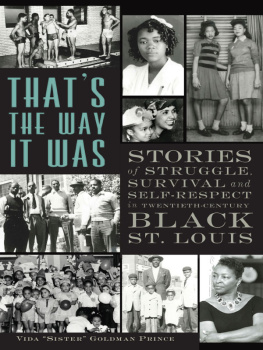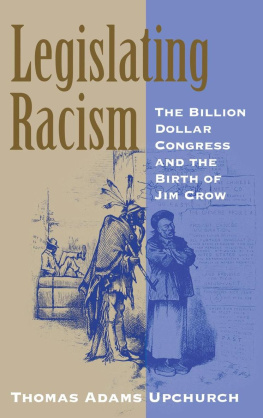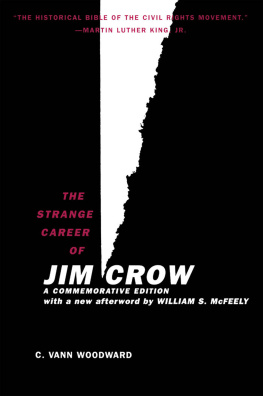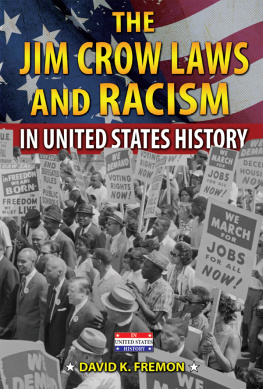
The Strange Careers of the Jim Crow North
The Strange Careers of the Jim Crow North
Segregation and Struggle outside of the South
Edited by Brian Purnell and Jeanne Theoharis, with Komozi Woodard

NEW YORK UNIVERSITY PRESS
New York
NEW YORK UNIVERSITY PRESS
New York
www.nyupress.org
2019 by New York University
All rights reserved
References to Internet websites (URLs) were accurate at the time of writing. Neither the author nor New York University Press is responsible for URLs that may have expired or changed since the manuscript was prepared.
Library of Congress Cataloging-in-Publication Data
Names: Purnell, Brian, 1978 editor. | Theoharis, Jeanne, editor. | Woodard, Komozi, editor.
Title: The strange careers of the Jim Crow North : segregation and struggle outside of the South / edited by Brian Purnell and Jeanne Theoharis, with Komozi Woodard.
Description: New York : New York University Press, [2019] | Includes bibliographical references and index.
Identifiers: LCCN 2018037657| ISBN 9781479801312 (cl : alk. paper) | ISBN 9781479820337 (pb : alk. paper)
Subjects: LCSH : African AmericansCivil rightsHistory20th century. | Civil rights movementsUnited StatesHistory20th century. | African AmericansSegregationHistory20th century. | RacismUnited StatesHistory20th century. | United StatesRace relationsHistory20th century. | Northeastern StatesRace relationsHistory20th century. | Middle WestRace relationsHistory20th century. | West (U.S.)Race relationsHistory20th century.
Classification: LCC E185.61 .S9143 2019 | DDC 323.1196/0730904dc23
LC record available at https://urldefense.proofpoint.com/v2/url?u=https-3A__lccn.loc.gov_2018037657&d=DwIFAg&c=slrrB7dE8n7gBJbeO0g-IQ&r=gT953V3c8BdcJV4pugGaWueY1IXCnXKbUfEC8Smo3jI&m=OM6f_RGB6AFJbX7ZQnlKZG-viPbauFZSSFMX80xJF_k&s=1_CPUgRHQfc_lwTdHSq9NQfCfj7TRZdbfx0BevJEW8M&e=
New York University Press books are printed on acid-free paper, and their binding materials are chosen for strength and durability. We strive to use environmentally responsible suppliers and materials to the greatest extent possible in publishing our books.
Manufactured in the United States of America
10 9 8 7 6 5 4 3 2 1
Also available as an ebook
Contents
Brian Purnell and Jeanne Theoharis
Shannon King
John S. Portlock
Kristopher Bryan Burrell
Balthazar I. Beckett
Laura Warren Hill
Mary Barr
Tahir H. Butt
Aliyah Dunn-Salahuddin
Say Burgin
Crystal Marie Moten
Peter B. Levy
Ayesha K. Hardison
Histories of Racism and Resistance, Seen and Unseen: How and Why to Think about the Jim Crow North
Brian Purnell and Jeanne Theoharis
In my travels in the North I was increasingly becoming disillusioned with the power structures there.... Many of them sat on platforms with all their imposing regalia of office to welcome me to their cities and showered praise on the heroism of Southern Negroes. Yet when the issues were joined concerning local conditions only the language was polite; the rejection was firm and unequivocal.
Martin Luther King Jr., November 1965
The concentration upon the South... should not lead to the inference that the attitudes and policies described here were peculiar to the South. Indeed, if there were time and space, it would be a simple matter to point out the many parallel lines of prejudice and discrimination against the Negro in the North, prejudice that often worked as great a hardship upon the race as it did in the South.
C. Vann Woodward, 1955
Americans have been taught that Jim Crows history lies in the South. The story begins in the 1880s and 1890s, when southern states, faced with interracial democracies that Reconstruction created, rewrote their constitutions to eliminate black people from civic life. We came here to exclude the Negro, one Mississippi politician explained at the states constitution convention in 1890. Nothing short of this will answer.
The North, as the story goes, frowned upon the Souths peculiarities, but turned a blind eye to that regions Jim Crow injustices; while imperfect, its own systems were open to change and racial progress. Courageous opponents of southern Jim Crow began to rise up against racism and white supremacy in the 1930s and 1940s, but it was not until the 1950s and 1960s that an intrepid movement of black people across the South, with help from northern black people, reached a crescendo. Thus began the heroic civil rights movement history that many Americans learn about in school. Southern blacks, with the help of a sympathetic media and northern white liberals, challenged racial segregation through a mass struggle, and the nation overthrew Jim Crow segregation. Amid these victories, in the late 1960s, northern black people, frustrated by their own lack of progress and supposedly lacking the community values and institutions that had undergirded the southern struggle, erupted in riots across the urban North. Popular narratives, student textbooks, Hollywood dramas, and documentaries tell this moving history of a triumphant southern movement and its northern demise.
The Strange Careers of the Jim Crow North tells different stories, seeking to reshape that dominant narrative. The essays in this volume shift our attention to histories of entrenched, endemic racism outside the South. In the liberal North, legal systems supported, and hid, practices of racial segregation. Robust fights against racism unfolded. People who dissented against the racial system were dismissed, disparaged, patronized, and punished. This anthology is part of a growing academic field that highlights the long history of northern racism and social movements that challenged northern racial discrimination and segregation.education, and employment, but Americans know little about this history. The southern story continues to hold sway, in part because it makes racism a regional malady rather than a national cancer, expressed in violence and epithets rather than policy imperatives and political sway. A moving tale of good guys, bad guys, and successful endings, the popular story of Jim Crow and its defeat resounds as proof of the courage of individual Americans and the strength of U.S. democracy.
What we do know about the North, we do not associate with the term Jim Crow. Northern black activists, however, used this terminology regularly, and they repeatedly made comparisons to the South to disrupt the national tendency to see systematized racism only as a regional issue. Extending into every region, state, and community, Jim Crow was a crucial feature of national life. Its strange careers outside of the South need fuller incorporation in histories of the United States during the twentieth century.
Jim Crow began in the North, not the South. Long before the Civil War, northern states like New York, Massachusetts, Michigan, New Jersey, Ohio, and Pennsylvania had legal codes that promoted black peoples racial segregation and political disenfranchisement. While these northern Jim Crow laws predated the Souths, these racial systems never dominated or defined the region in a uniform way. Throughout the nineteenth century, black and white abolitionists and free black activists challenged the Norths Jim Crow practices, won some victories, waged war against slavery in the South and the North, and even changed some of the Norths racist laws in housing, voting, education, and marriage. Nonetheless, northerners wove Jim Crow racism into the fabric of their social, political, and economic life in ways that shaped the history of the region, and the entire nation. Jim Crow, outside of the South, coexisted, even thrived, alongside efforts to reform its worst manifestations in social and political life. This characteristic distinguished it from its southern version. A commonplace saying captured the two Jim Crows perfectly: in the South, black people could get close to white people, so long as they did not become too uppity by advocating for their social, political, or economic equality with whites. In the North, black people could get as uppity as they wantthey could run successful businesses, consume luxury goods, and sit next to white people on the busso long as they did not try to get too close to whites, as their neighbors, sexual
Next page







